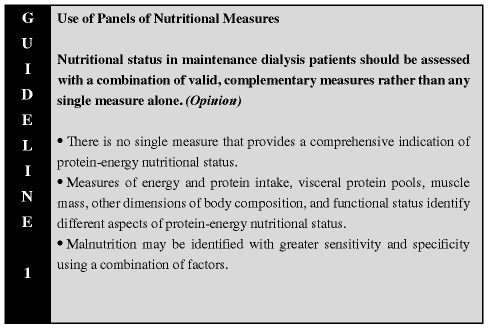
1. Evaluation of Protein-Energy Nutritional Status

Optimal monitoring of protein-energy nutritional status for maintenance dialysis (MD) patients requires the collective evaluation of multiple parameters, particularly using measures that assess different aspects of protein-energy nutritional status. No single measure provides a complete overview of protein-energy nutritional status. Each of the valid indicators described in Guidelines 2 and 23 has a role in the overall nutritional assessment of dialysis patients.
There are ample data suggesting that complementary indicators of nutritional status exhibit independent associations with mortality and morbidity in maintenance hemodialysis (MHD) and chronic peritoneal dialysis (CPD) patients. For example, the serum albumin, serum creatinine, and body weight-for-height are independently associated with survival.14 Data from theUSRDS confirm these findings, using the serum albumin and body mass index (BMI; kg/m2).15 In the CANUSA study, both the serum albumin and SGA were independent predictors of death or treatment failure.16 A discussion of why serum transferrin concentrations and bioelectrical impedance studies are not recommended for the nutritional assessment of MD patients in clinical practice is given in Appendix VIII.